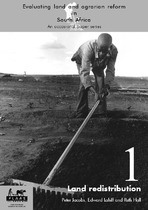| dc.contributor.author | Jacobs, Peter | |
| dc.contributor.author | Lahiff, Edward | |
| dc.contributor.author | Hall, Ruth | |
| dc.date.accessioned | 2019-03-07T12:08:44Z | |
| dc.date.available | 2019-03-07T12:08:44Z | |
| dc.date.issued | 2003 | |
| dc.identifier.citation | Jacobs, P., Lahiff, E. & Hall, R., 2003. Land Redistribution. Cape Town: Institute for Poverty Land and Agrarian Studies (PLAAS). | en_US |
| dc.identifier.isbn | 1-86808-579-1 | |
| dc.identifier.uri | http://hdl.handle.net/10566/4423 | |
| dc.description.abstract | Land dispossession during the colonial era and the decades of apartheid rule produced a highly unequal pattern of land ownership and widespread rural poverty in South Africa. When a democratically elected government came to power in 1994, it adopted a land reform programme to address the problems inherited from the past and the challenge of development in the rural areas.
The land reform programme of the South African government is conventionally described as having three legs: restitution, tenure reform and redistribution. While restitution deals specifically with historical rights in land, and tenure reform with forms of land holding, redistribution is specifically aimed at transforming the racial pattern of land ownership. | en_US |
| dc.language.iso | en | en_US |
| dc.publisher | Institute for Poverty Land and Agrarian Studies (PLAAS) | en_US |
| dc.relation.ispartofseries | Evaluating land and agrarian reform in South Africa;1 | |
| dc.subject | Land distribution | en_US |
| dc.subject | Land transferred | en_US |
| dc.subject | Agrarian reform | en_US |
| dc.subject | Land dispossession | en_US |
| dc.title | Evaluating land and agrarian reform
in
South Africa : Land redistribution | en_US |
| dc.type | Book | en_US |

